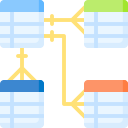Custom Database Development Service
Custom Database Development
- Our team specializes in custom database development, ensuring your data is stored, managed, and processed with maximum efficiency.
- We design and tailor databases to meet your specific business requirements, enabling seamless integration with your software applications.
- With our expertise, you can trust us to deliver robust and scalable database solutions.

Key Aspects of Custom Database Development

Requirement Analysis
Understanding business needs and defining the database structure accordingly

Database Design
Creating an efficient schema, including tables, relationships, indexes, and constraints

Data Modeling
Using ER diagrams and normalization techniques to avoid redundancy and improve efficiency

Database Development
Implementing tables, stored procedures, triggers, and views using SQL or NoSQL databases

Integration
Connecting the database with web applications, mobile apps, or enterprise systems

Security & Access Control
Implementing user authentication, encryption, and role-based access

Backup & Recovery
Setting up automated backups and disaster recovery plans

Performance Optimization
Indexing, query optimization, and caching for faster data retrieval

Scalability
Designing for future growth with distributed databases or cloud solutions
Why Choose Custom Database Development?
Tailored to Business Needs
Unlike generic databases, custom databases align with specific business processes.
Improved Performance
Optimized queries, indexing, and caching for faster data retrieval.
Enhanced Security
Custom security policies, encryption, and role-based access controls.
Scalability & Flexibility
Designed to grow with business expansion and accommodate evolving requirements.
Seamless Integration
Can be integrated with web apps, mobile apps, CRM, and other enterprise tools.
